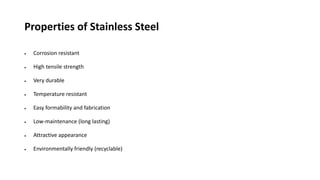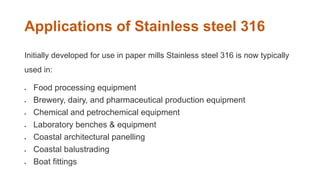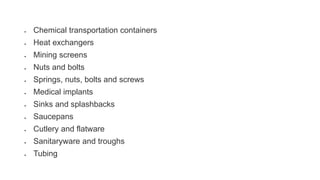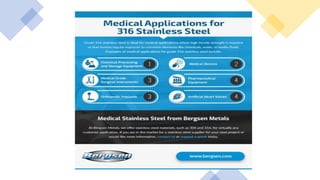UNIT-2 METALIC IMPLANTS-STAINLESS STEEL.pdf
- 2. STAINLESS STEEL • Stainless steel is the name of a family of iron-based alloys known for their corrosion and heat resistance. One of the main characteristics of stainless steel is its minimum chromium content of 10.5%, which gives it its superior resistance to corrosion in comparison to other types of steels. Like other steels, stainless steel is composed primarily from iron and carbon, but with the addition of several other alloying elements, the most prominent being chromium. Other common alloys found in stainless steel are nickel, magnesium, molybdenum, and nitrogen.
- 3. STAINLESS STEEL FAMILIES: FOUR OPTIONS WITH UNIQUE PROPERTIES • Families refer to specific properties and give an idea as to the ratio of various metals in the alloy. Stainless steel falls into four distinct families: • Austenitic Stainless Steel • Ferritic Stainless Steel • Duplex Stainless Steel • Martensitic & Precipitation Hardening Stainless Steel
- 5. • Older grades often feature a three-digit identifier established by the Society of Automotive Engineers (SAE). • However, you might also see grades in North America identified using a six-character identifier set by the and American Society for Testing and Materials (ASTM). • These are known as Unified Number System (UNS) identifiers. You can find a full list of common identifiers here. • In many cases, UNS identifiers share the same first three numbers as their AISI equivalent. But there’s also grading systems created by: • British Standards (BS) • International Organization for Standardization (ISO) • Japanese Industrial Standards (JIS) • European Standard (EN) • German Standard (DIN) • Chinese Standard (GB)
- 6. Properties of Stainless Steel • Corrosion resistant • High tensile strength • Very durable • Temperature resistant • Easy formability and fabrication • Low-maintenance (long lasting) • Attractive appearance • Environmentally friendly (recyclable)
- 7. Grading systems for stainless steel • There are many numerical grading systems for stainless steel, designated according to their composition, physical properties, and applications. Each type of stainless steel is classified by its series number and then assigned a numerical grade. The most popular series numbers are 200, 300, 400, 600, and 2000. The most common grades are type 304 and 316 that consist of austenitic chromium-nickel alloys. Cutlery grade stainless steels are found in the 400 Series, which is derived from ferritic and martensitic chromium alloys. Type 420 is known as surgical steel, and type 440 is known as razor blade steel. • Stainless steel types 1.4401 and 1.4404 are also known as grades 316 and 316L respectively. Grade 316 is an austenitic grade second only to 304 in commercial importance. Stainless steel types 1.4401 and 1.4404 are also known as grades 316 and 3164L respectively. Grade 316 is an austenitic grade second only to 304 in commercial importance.
- 8. • 316 Stainless Steel • Stainless steel 316 contains an addition of molybdenum that gives it improved corrosion resistance. This is particularly apparent for pitting and crevice corrosion in chloride environments. • 316L Stainless Steel • 316L, the low carbon version of Stainless steel 316, is immune to grain boundary carbide precipitation (sensitisation). This makes it suited to use in heavy gauge (over about 6mm) welded components. • 316Ti and 316H Stainless Steels • For elevated temperature applications the high carbon variant, 316H stainless steel and the stabilised grade 316Ti stainless steel should be employed. • The austenitic structure of Stainless steel 316 gives excellent toughness, even at cryogenic temperatures.
- 9. • ASTM A240/A240M • Property data given in this document is typical for bar and section products covered by EN 10088- 3:2005. ASTM, EN or other standards may cover all products sold. It is reasonable to expect specifications in these standards to be similar but not necessarily identical to those given in this datasheet. • Stainless steel grade 316Ti contains a small amount of titanium. Titanium content is typically only around 0.5%. The titanium atoms stabilise the structure of the 316 at temperatures over 800°C. This prevents carbide precipitation at the grain boundaries and protects the metal from corrosion. The main advantage of 316Ti is that it can be held at higher temperatures for a longer period without sensitisation (precipitation) occurring. 316Ti retains physical and mechanical properties similar to standard grades of 316.
- 10. Chemical Composition of Stainless steel 316 % 316 316L 316H 316Ti C 0.0-0.07 0.0-0.03 0.04-0.08 0.0- 0.08 Mn 0.0-2.0 0-2.0 0.0-2.00 0.0-2.00 Si 0.0-1.0 0.0-1.00 0.0-1.00 0.0- 1.00 P 0.0-0.05 0.0-0.05 0-0.04 0.0-0.05 S 0.0-0.02 0.0-0.02 0.0-0.02 0.0-0.03 Cr 16.50-18.50 16.50-18.50 16.50-18.50 16.50- 18.50 Mo 2.00-2.50 2.00-2.50 2.00-2.50 2.00- 2.50 Ni 10.00-13.00 10.00-13.00 10.00-13.00 10.50- 14.00 Ti - - - 0.40- 0.70 Fe balance balance balance balance
- 11. Properties of Stainless Steel 316 Mechanical Properties of Stainless Steel 316 Grade 316 Bar and Section (up to 160 mm thick) 316 Sheet (up to 8 mm thick) 316 Plate (8 - 75 mm thick) 316L Bar and Section (up to 160 mm) 316L Sheet (up to 8 mm thick) 316 L Plate (8 - 75 mm thick) 316H Bar (up to 160 mm) 316Ti Bar (up to 160 mm) Tensile Strength (MPa) 500 - 700 530 - 680 520 - 670 500 - 700 530 - 680 520 - 670 490 - 690 500 - 700 Proof Stress (MPa) 200 Min 240 Min 220 Min 200 Min 240 Min 220 Min 205 Min 200 Min Elongation A50 mm 40 Min % 40 Min % 45 Min % 40 Min % 40 Min % 45 Min % 35 % 40 Min % Hardness Brinell 215 Max HB - - 215 Max HB - - - 215 Max HB
- 12. Physical Properties of Stainless Steel 316 Property Value Density 8.00 g/cm3 Melting Point 1400°C Modulus of Elasticity 193 GPa Electrical Resistivity 0.74 x 10-6 Ω.m Thermal Conductivity 16.3 W/m.K Thermal Expansion 15.9 x 10-6 /K
- 13. Applications of Stainless steel 316 Initially developed for use in paper mills Stainless steel 316 is now typically used in: • Food processing equipment • Brewery, dairy, and pharmaceutical production equipment • Chemical and petrochemical equipment • Laboratory benches & equipment • Coastal architectural panelling • Coastal balustrading • Boat fittings
- 14. • Chemical transportation containers • Heat exchangers • Mining screens • Nuts and bolts • Springs, nuts, bolts and screws • Medical implants • Sinks and splashbacks • Saucepans • Cutlery and flatware • Sanitaryware and troughs • Tubing















